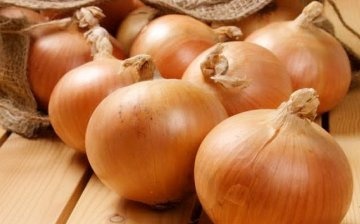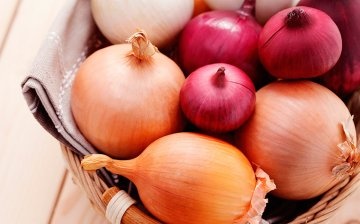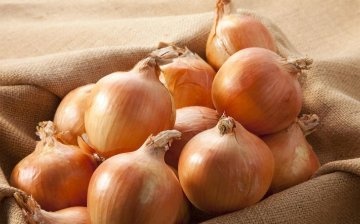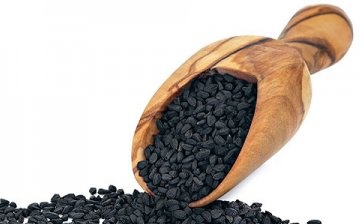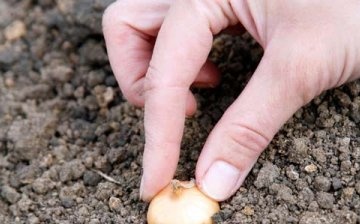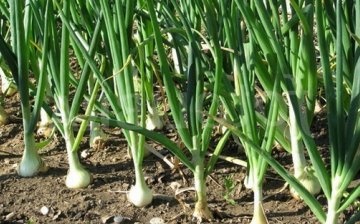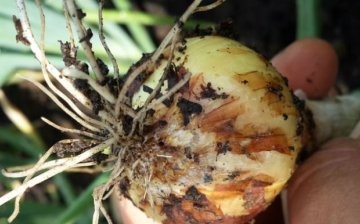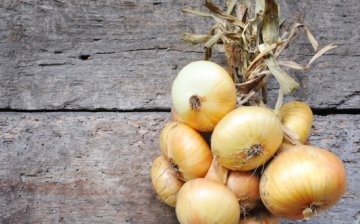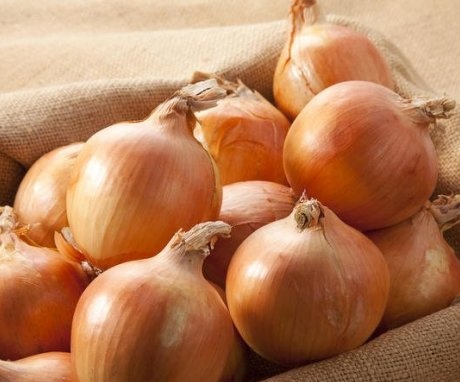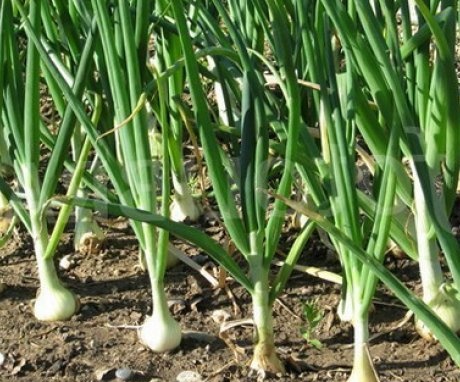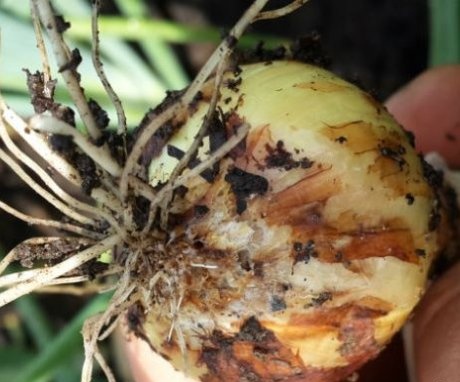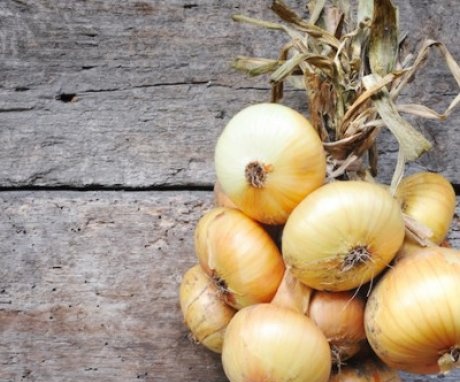Onions - growing: from planting to harvesting
Bulb onions appeared more than four centuries ago. He came from Ancient Egypt. Onions are an indispensable ingredient in cooking and an effective medicine in traditional medicine. It has a pungent taste and peculiar smell, and due to the content of phytoncides, it is effective against pathogenic microorganisms. No wonder this vegetable king is called "Onion - from seven ailments". It is able to improve the taste characteristics of dishes and aids in the assimilation of food.
It is not difficult to grow onions, but sometimes it takes two years to get a harvest from commercial large bulbs. They grow it not only for their own consumption, but also for sale. This is a profitable activity, because with proper agricultural technology, collection and subsequent storage, onions are able to maintain their presentation until the next harvest.
Content:
- Choosing the best onion varieties to grow
- Conditions for growing onions
- Reproduction methods
- Onion care
- Diseases, pests and control of them
- Harvesting and storage
Choosing the best onion varieties to grow
When choosing an onion variety for planting, you need to take into account its characteristics and cultivation conditions. In any case, it should be an unpretentious variety with good yield and high keeping quality.
The best of the fruitful varieties:
- Aleko. The variety is of medium ripening, the heads have a pronounced purple color. Full maturation occurs in 3-3.5 months from the moment of disembarkation. The characteristic features of onions are high yields and a lot of greenery. 2-3 onion heads weighing 90-100 grams each come out of one nest of the variety. Pros: long-term storage, rich harvest, sharp taste.
- Golden. As a result of a long and difficult selection, a medium-ripening variety was bred with golden rounded flatish clucks, thanks to which it got its name. Golden has a white pulp with greenery and a high yield, 2-3 kg comes out from 1 m2. Bulbs of different diameters, weighing from 50 to 130 grams. Pros: high keeping quality, large heads, good taste characteristics.
- Timiryazevsky. Suitable for cultivation in northern climates. The bulbs are firm with a round or flattened shape and white flesh, each weighing 50-70. The husk is yellow-golden. Output 3.5 kg from 1 m2. Pros: high yield, good preservation, adapted to the whims of nature, short ripening period.
The best varieties of onions for storage:
- Stuttgarter rizen. Bred by German breeders. Refers to early maturing varieties. Ripens in 70 days after planting the seedlings. The head is flattened-round up to 150 grams in weight, the pulp is sharp in taste. Productivity up to 5 kg per 1 m2. Minimal care. Pros: high yield, good keeping quality, selected even bulbs of good presentation, immunity against false powdery mildew.
- Sturon. Riesen, derived from the Stuttgarten variety, produces high quality heads with a regular round shape.But unlike their parent, they have a smaller nose and a thinner neck, due to which the amount of waste is reduced and drying is accelerated. Gives a rich harvest.
- Orion. Yields a good harvest from even round bulbs, each weighing up to two hundred grams. It ripens early, therefore it can grow in the northern regions. Keeping quality is high. It is considered the most popular variety for gardeners. Stored well.
Conditions for growing onions
An important advantage Luke is its frost resistance. Seeds can germinate at a temperature of 5-6 degrees above zero, and 15 degrees is considered a comfortable temperature for growth. Adult onions of spicy varieties easily tolerate six-degree frosts, and for sweet ones, three-degree frost can pose a threat.
It should be noted that onions are lovers of loose and nutritious soil with neutral or slightly alkaline PH and abundant sunlight. And the proximity to weeds has a depressing effect on the crop. It is demanding for watering during active development.
It is advisable to plant onions in an elevated area, and the soil should be saturated with nutrients.
The place after cucumbers, beans, peas, cabbage and potatoes, which were fed with manure fertilizers, because the introduction of fresh manure directly for onions is not recommended. The culture will start to get sick and will not mature. For fertilizers onions, a mixture of humus with superphosphate, ammonium nitrate and potassium salt is suitable.
They begin to prepare the soil after clearing the site from last year's planting. The soil is loosened to a depth of 6 centimeters. In mid-September, the soil is re-dug up (depth on the bayonet of a shovel) together with superphosphate. Due to the fact that onions are planted early, the site needs to be fertilized with humus immediately after the snow cover has melted and form beds, 15 to 25 cm high and 40 cm wide. into the ground.
Reproduction methods
There are several ways to propagate onions:
- Seed - by sowing onion seed.
- Sevkovy.
Seed method. It involves sowing nigella - onion seeds in the ground. As a result, the set will be ready for the next season. Seed materials are either purchased or harvested on their own. To do this, in spring or autumn on the seeds adult heads are planted, which by the middle of summer release arrows with spherical inflorescences at the ends.
After flowering in place of the inflorescences, black seeds are formed, which are collected, dried and stored in a cloth bag until planting.
Before sowing, the seeds are sorted, selecting healthy and large specimens. To do this, you can use a sieve. For rapid germination, the seeds are soaked in methylene blue or manganese solution for a day and placed in burlap until sprouts appear. Do not allow the seeds to dry out. Sowing germinated seeds into prepared furrows with a compacted bottom, which are done at intervals of 20 centimeters. They deepen the seeds by 2-4 centimeters and mulchusing peat or humus.
Winter sowing of nigella can also be carried out. The seeds are buried 1.5-2 cm and mulched. In the spring, when the temperature rises to 3-4 degrees, the seeds will germinate. The winter method allows you to get sowing earlier.
Sevkovy method:
- Sevok is sorted out, selecting heads with a diameter of 0.5 cm to 3 cm.
- The purchased material is preliminarily placed in a cardboard box and heated on a battery for 9-12 hours. Home sevok does not need warming up.
- Next, the bulbs are soaked in a mineral solution or growth stimulator for about ten hours and spend disinfection copper sulfate diluted with water.
- The roots should be treated with wood ash.
- Seed material is buried 5-6 centimeters into the ground at temperatures above 10 degrees Celsius so that the seed arrow does not grow.
- A ten-centimeter interval is observed between the bulbs, and 20-25 cm between the rows.
- The soil is mulched with peat.
- The feathers will hatch within a week.
Onion care
Culture care includes:
- Watering... The crop should be watered abundantly in May, June and the first half of July. Irrigation is carried out once a week. It is during this period that onions are actively developing. By the end of July, watering should be excluded so that the ripening bulbs do not become watery.
- Loosening the soil. The soil should be loosened to a depth of 2-3 cm to prevent the appearance of a crust or its removal. Also, loosening helps prevent onion diseases and the reproduction of earthen pestsand also reduce the overgrowth of weeds. Such manipulations enrich the soil with oxygen and improve the access of moisture and nutrients.
- Weeding. The beds should be weeded regularly, as weeds have a detrimental effect on the onion crop. Destroy weeds follows while they are still small. Otherwise, the overgrown root system weeds, can move the bulbs and damage the roots, as a result of which the onion will stop developing. Weeding is carried out after the soil is well moistened.
- Top dressing... For the first time, plants are fed 14-16 days after planting, using mullein solution or diluted chicken droppings with the addition of urea. Fertilizers made from ammonium nitrate are also suitable. The second procedure is carried out two to three weeks later by mixing bird droppings or mullein with superphosphate and potassium fertilizers in equal proportions. The third stage of fertilization is carried out when the bulbs reach their maximum size. At this stage, complex feeding is used. The slowed down development of feathers indicates a lack of nutrients. Onions should be fed organic or mineral fertilizers.
Experienced farmers recommend planting around onions dill and marigold, which prevent the appearance of harmful insects and the defeat of onions by a nematode. And the carrots growing nearby will not allow the onion fly to the culture.
Diseases, pests and control of them
Onions are susceptible to damage by many pests and diseases... The most dangerous are diseases of bulbous root crops, which include stem nematodes, damage by larvae of flies (onion and hoverflies), rotting of the bottom.
For the active development of bulbs, the health of green feathers is necessary, which are often damaged by onion burrowers, tobacco thrips, downy mildew and smut. The crop should also be protected when storage, because it can be destroyed by onion mites or gray neck rot.
Prevention and treatment:
- Prevention against tobacco thrips is the pre-planting of the onion with hot water cooled in ice water and the annual change of landing sites. Modern drugs are used to control pests.
- Planted next door will help against onion flies carrot and brine treatment. For prevention, crops should be alternated and onions should be planted early.
- Following the root mite attack will help to avoid crop rotation, removal of plant residues and disinfection of planting material and soil with colloidal sulfur.
- The crop is protected from the onion mite by decontaminating and ventilating the storage facilities. To prevent insect attacks, the soil is dug deeply, cleaned of rotting plant debris and spraying with sulfur. This spraying is also practiced before harvesting.
- The lurker is scared away by scattering wood ash, ground black and red peppers, dry mustard, loosening row spacings and dusting the soil in the root zone. During the growing season, onions are sprayed chemicals.
- Early planting, timely introduction top dressingspraying with antifungal drugs.Treatment includes avoiding watering and nitrogen fertilization. Harvested with green foliage, but with formed heads. The foliage must be cut and burned, and the bulbs must be dried well in the sun for two weeks.
Harvesting and storage
Lodging of onion feathers and drying of the neck are a signal to start harvesting. This happens in August. The onions are pulled out of the ground and left to ripen and dry, then they are moved to the place storagewhich must be dry and ventilated to dry completely.
Harvesting is recommended in clear windy weather, for better drying.
Ultraviolet rays help disinfect the bulbs. Vegetables are removed from the ground and left in place until evening, periodically turning over. In the evening or the next day, the foliage is cut off and sent to a warm room (attic or barn floor) to dry completely. Many gardeners dry onions outdoors, weather permitting, until the tops are completely dry. And only after that they are sent to storage.
Completely dried onions should have a dry and thin neck. When the vegetables are well dry (after about two weeks), they are collected in boxes, baskets or ventilated boxes and sent to storage. In another method of storage, farmers do not cut their tails, but weave braids from a bow with an interwoven rope for a fortress and store them in a suspended state, for example, on the rafters of the attic or specially installed beams in the barn.
More information can be found in the video:



